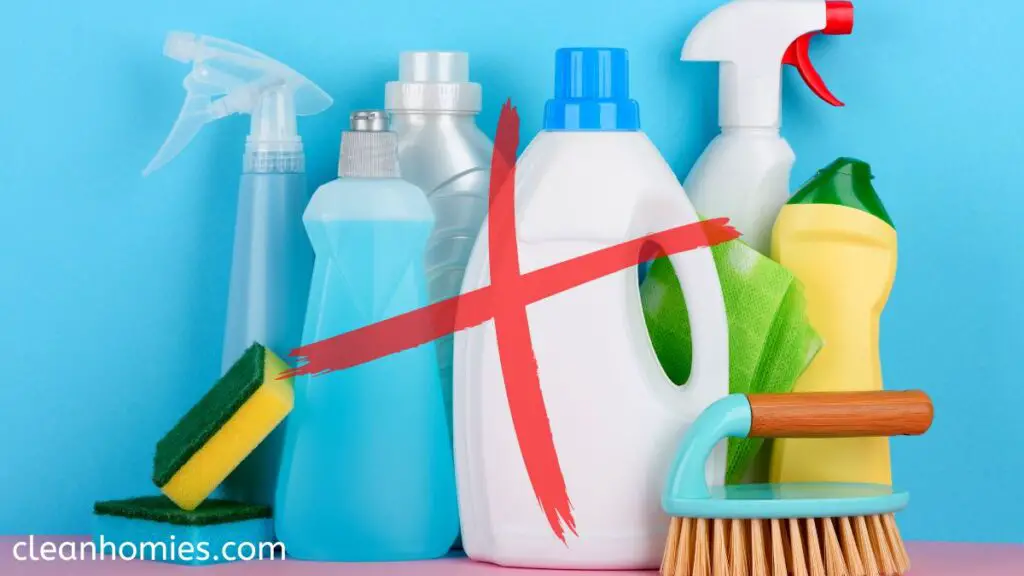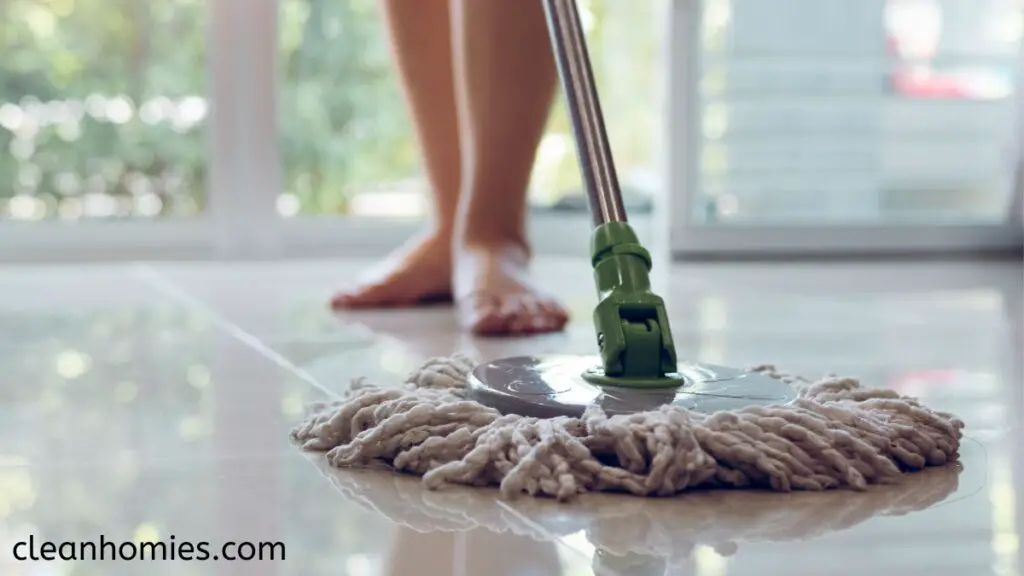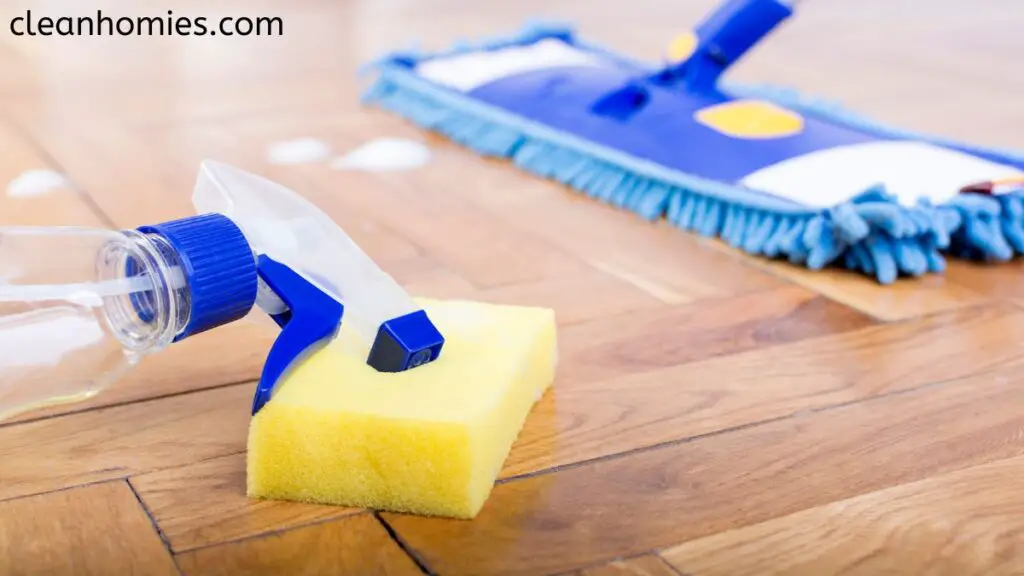Even after you mopped and cleaned the floor, sticky hardwood floors can be pretty frustrating. So if you are worried as to why your hardwood floors sticky, here are the possible reasons:
We’re here to help you eliminate the hardwood floor’s stickiness. Take notes of the precise reason with solutions provided in this expert guide!
🧐Why Are My Hardwood Floors Sticky After Mopping?
| Causes | How it makes the floor sticky? | How to fix it? |
| Wrong cleaning solution | Not every cleaning solution is made for hardwood floors. If you use a solution made to clean ceramic tile or natural stone. It will make wood floors sticky. | Read the label of your cleaning solution carefully while buying. |
| Wrong water-cleaner ratio | Not using the prescribed amount of water-cleaner ratio leads to sticky flooring or soapy residue. | Use a measuring cup to measure the amount of water-cleaner ratio. |
| Using unclean water | Mopping with dirty water leads to redistribution of filth hence making the floor dirty looking and sticky. | After cleaning the floor, rinse everything with fresh water. Use microfiber mops as they are known to absorb dirt better. |
| Not mopping properly | Not mopping the floor properly or using worn-out and old cleaning equipment which doesn’t absorb dirt properly will lead to a dirty floor, still sticky. | Change mop heads after every 20-30 uses. Cleans mops with clean water after every use |
| Not drying the floor after mopping | Not drying the floor after mopping the floor with a cleaning solution can result in sticky residue on the floor. | Use a soft cloth that won’t scratch the floor to dry the floor after mopping. |
Also Read: Tineco Ifloor 3 vs Floor One S3
❌Wrong cleaning solution

Numerous floor cleaning solutions on the market make various claims about their quality. However, not every cleaning solution is made for your floor.
There are many types of flooring, including laminate, vinyl, ceramic tile, hardwood, and natural stone. Unfortunately, most cleaning solutions work only for specific kinds of surfaces.
For example, a cleaning solution made for laminate or ceramic tile flooring will not work for your hardwood floor and will leave a sticky residue and a dirty floor. Using the wrong cleaning solution can even ruin your floor.
⚙How to fix
A quick tip:
Dish soap(up to 59 ml) or white vinegar (up to 120 ml) mixed with a bucket (one gallon) of hot water can work as an effective cleaning agent.
Also Read: Steps To Clean Balcony Floors
💦Wrong water-cleaner ratio

Using excess cleaner will make your solution soapy and the floor sticky and slippery, as the cleaning material will sit on your floor after drying. On the other hand, if you use too much water, the solution will not be effective. This is because the floor will still not be clean after mopping.
🔩How to fix
Do not dilute your mopping solution too much or too little. Instead, follow the mixing directions and use the amount of recommended cleaner on the label. Additionally, you can use a measuring cup to ensure the quantity.
Also Read: Best Ways To Dump Mop Water
💩Using polluted water

Using polluted water to mop your floor will invite the same dirt and debris you’ve been trying to clean all this time. It becomes a vicious cycle of floor dirt if you keep mopping your floor with contaminated water.
🔨How to fix
A quick tip
If you have a lot of dirt on your floor daily, consider getting a microfiber mop, as it can hold more dirt.
Also Read: 7 Reasons Why Dyson Vacuum Smells Bad
👎Not mopping properly

Cleaning your sticky floors can be a rigorous physical activity. However, your efforts will be wasted if your mop is not clean as it should be.
Low-quality, old and worn-out mops cannot clean the floor properly. They cannot retain the cleaner or water properly, making the floor sticky and not clean.
🛠How to fix
Also Read: Step-By-Step Tutorial To Clean Ash Out Of Carpet
🔥Not drying the floor after mopping

Drying your floor after cleaning is crucial to maintaining the quality of your floor because hardwood floors are vulnerable to water damage. To avoid discoloration on your floor, you should dry the floor after mopping.
⚒How to fix
To remove sticky residue, utilize techniques to dry the floor, such as air drying or towel drying.
Also Read: Can You Use Fabuloso on Hardwood Floors?
👀Why do my hardwood floors feel sticky? [Solved]
| Reasons | How it makes the floor sticky? | How to fix it? |
| The protective coating is damaged | The protective coating softens due to heat and humidity in the environment, making the whole floor sticky. | Maintain room temperature between 70-75 degrees Fahrenheit. Use warm water and vinegar solution. |
| Dirt buildup on the floor | Dirt and debris can scratch and dull the top layer of the floor. | Weekly cleaning, Use rags and carpets to prevent dirt from entering your house. |
| Cleaning residue | Chemical in cleaners leaves a sticky residue if not diluted properly. | Dilute the cleaning solution according to the direction given on the label. |
Also Read: 5 Sure-Fire Ways To Clean Unfinished Wood Flooring
☢The protective coating is damaged

The primary purpose of the flooring’s protective top coat (like polyurethane) is to maintain the shine and protect the flooring from wear and tear. However, with time this protective coating gets damaged. It becomes sticky and tacky due to heat and humidity in the environment.
Solution:
You might need to remove the floor’s top coating to remove the previous polyurethane coating and redo it. When cleaning floors, use a wax-based cleanser to stop the coating from peeling or cracking. Maintain a room temperature of 70 to 75 degrees Fahrenheit.
Also Read: How to Remove Sticky Residue From Laminate Flooring
🤢Dirt buildup on the floor

Filth and buildup on the flooring are brought on by bringing mud, dirt, and other materials inside the house with your footwear.
Solution:
Use a horsehair brush attachment designed exclusively for vacuuming hardwood floors. Try using a microfiber mop head to take up and retain dirt.
🍃Cleaning residue

Most cleaning products are made of water, solvents to break down debris, and surfactants to suspend dirt and make it easier to wipe away. Unfortunately, these surfactants are the reason for the sticky residue left on your floors.
Your floors may be quite sticky if you are not adequately diluting your floor cleaner due to the residual.
Solution:
Follow the instructions and dilute your concentrated cleaning solution as directed on the label. Mop the floor with clean water after cleaning with a cleaning solution.
Also Read: Should You Vacuum Hardwood Floors?
🤔Hardwood Floor Cleaning: FAQs
Does vinegar make floors sticky?
Using undiluted vinegar might result in sticky areas on your wood floors. However, it can also be used as an effective floor-cleaning solution when diluted with water.
What works best on sticky floors?
The slightly acidic cleaner works best to clean sticky floors like a mix of white distilled vinegar and water. However, for wooden floors, a particular hardwood cleaning solution works perfectly.
Is it ok to mop hardwood floors?
It is completely fine to clean hardwood floors with the right cleaning solution and a flat mop.
Is it better to vacuum or mop hardwood floors?
Sweeping is a better approach to cleaning hardwood floors and removing sticky residue than vacuuming, as its strong brush attachments can damage hardwood floors.
How often should you mop hardwood floors?
One should mop their wood floor in living rooms and guest areas twice a week as the flooring there is most exposed to dust and traffic. Sweep places with less footfall once a month.

Adarsh is a Health Science graduate with expertise in environmental health and wellness. He is a Neat Freak who constantly looks for ways to keep his surroundings clean. At Clean Homies, Adarsh is focused on researching and sharing information on how you can maintain hygiene at home for a happy life.

